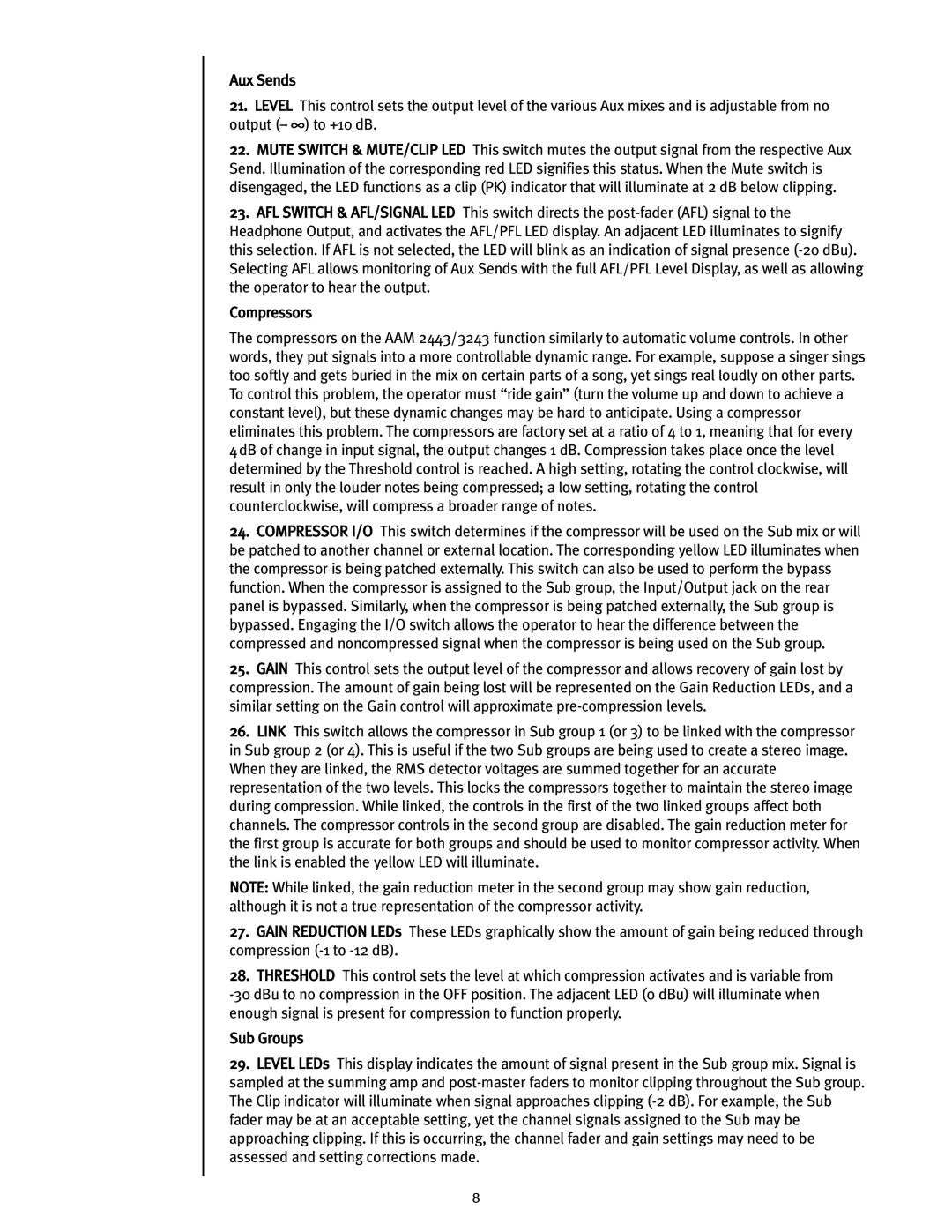Aux Sends
21.LEVEL This control sets the output level of the various Aux mixes and is adjustable from no output (– ∞) to +10 dB.
22.MUTE SWITCH & MUTE/CLIP LED This switch mutes the output signal from the respective Aux Send. Illumination of the corresponding red LED signifies this status. When the Mute switch is disengaged, the LED functions as a clip (PK) indicator that will illuminate at 2 dB below clipping.
23.AFL SWITCH & AFL/SIGNAL LED This switch directs the
Compressors
The compressors on the AAM 2443/3243 function similarly to automatic volume controls. In other words, they put signals into a more controllable dynamic range. For example, suppose a singer sings too softly and gets buried in the mix on certain parts of a song, yet sings real loudly on other parts. To control this problem, the operator must “ride gain” (turn the volume up and down to achieve a constant level), but these dynamic changes may be hard to anticipate. Using a compressor eliminates this problem. The compressors are factory set at a ratio of 4 to 1, meaning that for every 4dB of change in input signal, the output changes 1 dB. Compression takes place once the level determined by the Threshold control is reached. A high setting, rotating the control clockwise, will result in only the louder notes being compressed; a low setting, rotating the control counterclockwise, will compress a broader range of notes.
24.COMPRESSOR I/O This switch determines if the compressor will be used on the Sub mix or will be patched to another channel or external location. The corresponding yellow LED illuminates when the compressor is being patched externally. This switch can also be used to perform the bypass function. When the compressor is assigned to the Sub group, the Input/Output jack on the rear panel is bypassed. Similarly, when the compressor is being patched externally, the Sub group is bypassed. Engaging the I/O switch allows the operator to hear the difference between the compressed and noncompressed signal when the compressor is being used on the Sub group.
25.GAIN This control sets the output level of the compressor and allows recovery of gain lost by compression. The amount of gain being lost will be represented on the Gain Reduction LEDs, and a similar setting on the Gain control will approximate
26.LINK This switch allows the compressor in Sub group 1 (or 3) to be linked with the compressor in Sub group 2 (or 4). This is useful if the two Sub groups are being used to create a stereo image. When they are linked, the RMS detector voltages are summed together for an accurate representation of the two levels. This locks the compressors together to maintain the stereo image during compression. While linked, the controls in the first of the two linked groups affect both channels. The compressor controls in the second group are disabled. The gain reduction meter for the first group is accurate for both groups and should be used to monitor compressor activity. When the link is enabled the yellow LED will illuminate.
NOTE: While linked, the gain reduction meter in the second group may show gain reduction, although it is not a true representation of the compressor activity.
27.GAIN REDUCTION LEDs These LEDs graphically show the amount of gain being reduced through compression
28.THRESHOLD This control sets the level at which compression activates and is variable from
Sub Groups
29.LEVEL LEDs This display indicates the amount of signal present in the Sub group mix. Signal is sampled at the summing amp and
8
